You might not want to hear this…
…but the fact is that your content may not deserve to rank #1 in search engines.
Only one piece of content can rank first for each search query — that’s a fact. Google (and other search engines) work hard to ensure that the first result is the best content for that keyword.
Over the years, we know that Google is constantly refining and improving its algorithm that automatically ranks or scores pages based on content quality.
In addition, they have a large manual search team that grades pages based on Google’s latest quality guidelines.
Not surprisingly, the best content fulfills all those guidelines.
A few years ago, you could create good, unique content that wasn’t really good, but it was good enough to fool search engine algorithms. You could still rank for terms if you had the right off-page optimization.
But Google, in particular, has made incredible strides in the last few years. Most Google algorithm updates cause significant shifts in rankings. This update was the result of Google changing its core algorithm once again. It’s only going to keep improving from here.
We know that some of you are frustrated and angry because of those changes. It sucks if your traffic declines because your pages now rank lower. We understand that, but does your content deserve to be #1?
It probably doesn’t. Maybe it did before, and maybe it was surpassed. Regardless of why, the good news is that you can get your rankings back.
How? Create the best damn content out there. There are no secrets at this point.
Considering organic search still makes up about 53.3% of referral traffic, it’s worth it.
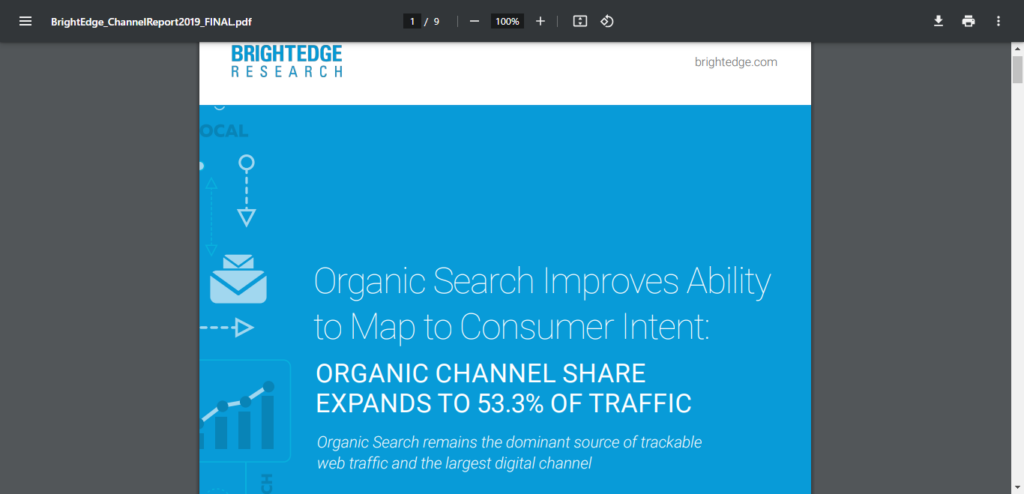
But how do you create the best content for your targeted keywords?
We’ll show you five different ways to take your content to the next level. If you do this, you will get much more search traffic. If you combine it with solid promotional tactics, you will grow your website rapidly.
1. Bigger is often better
When you’re looking to learn about SEO, email marketing, or any other topic, which would you prefer:
A list of three tips
or
A list of 20 tips?
There’s no question that the list of 20 tips will be more useful to more people than the shorter list.
Making something bigger (longer) is typically the easiest way to improve it.
According to an in-depth study by linchpinse, the highest-ranking pages are typically longer.
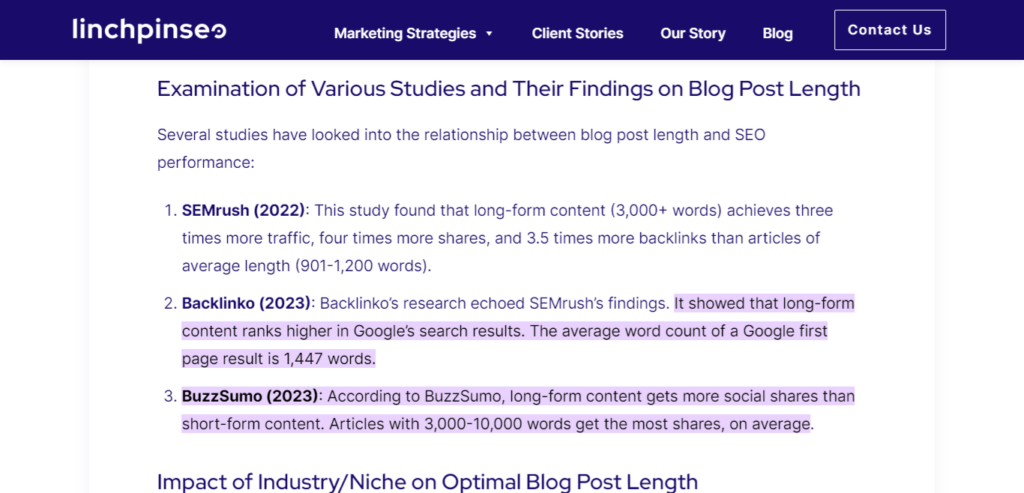
While there are some exceptions (such as an extremely narrow topic), packing in more information is usually better for the user, which is what search engines want.
Our personal experience shows that such posts are also more shareable, which indicates their usefulness. In the past, we’ve shared that our analysis of Quick Sprout posts found that posts over 1,500 words get an extra 68% more tweets and 22% more Facebook likes than shorter ones.
You’ll notice that Quick Sprout and the NeilPatel.com blog posts are usually very long (4,000-6,000 words) and do okay for search engine traffic.
You can make a post longer to improve it in two ways.
Option #1 – Add more items: The obvious option is to add more content to a post. The most common situation in which this is the best option is with a list post. Instead of 8 ways to do X, write 20 ways to do X.
If you’ve done your keyword research already, you can easily pick out terms in areas where people are looking for more. Typically, the best candidates are phrases that include the words:
- tips
- strategies
- tactics
- ideas
- ways
If you’d like to find more of these, use the Google Keyword Planner. Type in your main niche (e.g., health, marketing, decorating, etc.), along with any of the above words.
For example, if we wanted to create a monster list post for the case study site, we could search for health tips in the tool:

Without even scrolling down much, you could see that quite a few keywords could be great targets. The fact that they don’t have a huge search volume (but still decent) means that there’s a better chance that no one else has created amazing content around the keyword (would you rather compete against QuickSprout.com or supercoolhealthtips.com?).
Copy down those keywords, and then search them one by one. Look at the top few results:
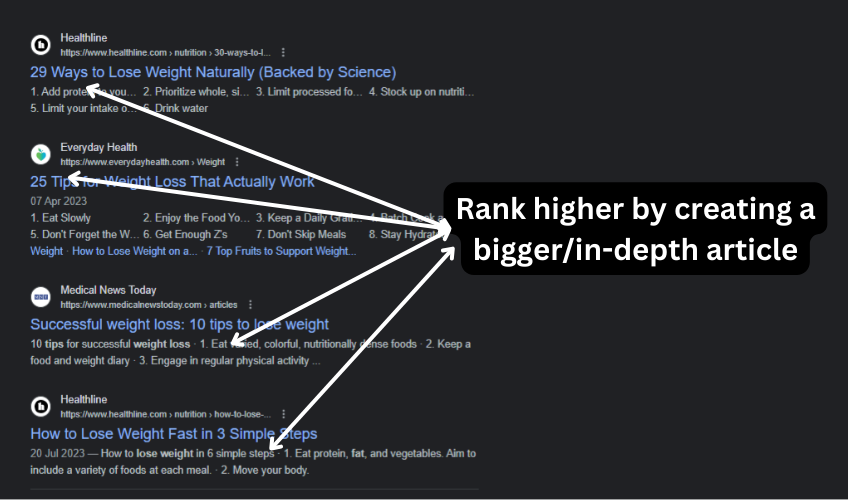
Searching for weight loss tips brought up almost exclusively list posts, and that’s what we want to see. In addition, they are all relatively short, which means that you can easily create a longer list.
Option #2 – Add more detail: Many lists lack the depth needed to be useful. If your tip is to weigh out your food carefully, that assumes that readers know why they should do that and how to do it.
If you were looking for health tips, would you rather have a simple or detailed actionable list?
For example, the #1 weight loss tips result from the above search looks like this:

That is extremely plain and not very useful. If we’re writing a post like that, we include a much longer description underneath the tip. We could include:
- A list of the best foods (maybe pictures as well)
- A sample meal plan or snacking schedule
- An actionable shopping plan
- Some examples of how to combine foods most people don’t know
In addition, we could make it more actionable by showing step-by-step personal examples of how we add food.
Imagine you’re the reader in this situation and looking for health tips; which one would you rather read? The more detailed and actionable one, of course.
Here’s where the real power comes in: What if you made your tips more detailed and your list longer? Instead of just 10 Easy Weight Loss Tips, you could create 30 Easy Weight Loss Tips AND go into more detail for every single tip. That’s how you create a resource that deserves to be #1.
2. Help readers navigate the waters
We know it might’ve been a while, but can you remember what it was like when you were first trying to learn about Internet marketing?
You knew absolutely nothing and had no clue where to start (although if you found Quick Sprout, we think you’re doing something right).
Additionally, the first few guides and e-books you found likely left you with more questions and confusion than you had when you started.
The good news is that when you’re introducing a new topic to a reader (big or small), you can make it easy for them. If your article can successfully educate a reader about a new topic more completely than any other alternative can, you deserve to rank #1.
Generally, there are three ways to make it easier for readers to understand your writing.
Option #1- Make it clearer: Start by breaking down things as much as possible. Use words that almost all readers are familiar with, and don’t try to tackle a huge topic simultaneously.
For example, we won’t try to teach you how to succeed as a marketer in a single post. Instead, we pick a much smaller part of marketing and go into it with more detail. That allows us to really break things down for you.
Use metaphors, similes, and analogies wherever possible to describe complicated (abstract) concepts. If you don’t remember those terms from your English classes, they basically describe ways of comparing two different things (in slightly different ways).
“Metaphors allow you to make the complex simple and the controversial palatable. Conversely, metaphors allow you to create extraordinary meaning out of the seemingly mundane.” – Brian Clark
The biggest advantage of comparisons is that they let you present your teachings in multiple ways. Hopefully, at least one will be clear to your readers.
Some are really obvious and can span an entire post.
Other comparisons can be used sporadically when a complicated subject comes up.
For example, in Neil Patel’s guide to growth hacking compared the growth hacker funnel (which most people have never heard of) to a car oil funnel. This specific example helped readers understand that traffic is like oil, and it needs to run down a funnel if it’s going to reach the destination, i.e., the engine (or growth for your website).
Besides comparisons, you can also use examples to help clear things up. When you hear a new concept, it often makes sense, but it’s not immediately obvious how you can actually apply it.
That’s why we try to include as many examples as possible when we advise you to do something. For example, when we wrote about writing emails to your subscribers to let them know about your new posts, we included an example of an actual email:

Finally, you can also use personal data or results from experimentation. For example, in this post, We shared with you the results of our personal Quick Sprout analysis of word count impact on share count. We regularly publish the results of our experiments to help you learn.
So even a piece of content that we think is pretty good (although we might be a little biased) can be improved in a number of ways.
Option #2 – Correct any mistakes: Have you ever heard that you can’t trust everything you read online? Most likely.
Although the web has a ton of amazing resources that you can access instantly, it also houses a ton of misinformation.
In addition, since pages never go away unless they are deleted or the website goes defunct, a lot of information is outdated.
For example, SEO guidelines have seen many changes in the past decade. What used to be good advice is now terrible advice.
You’ll still see results from the past few years if you search for Google ranking factors. Although they were good posts at the time, they now contain mistakes.
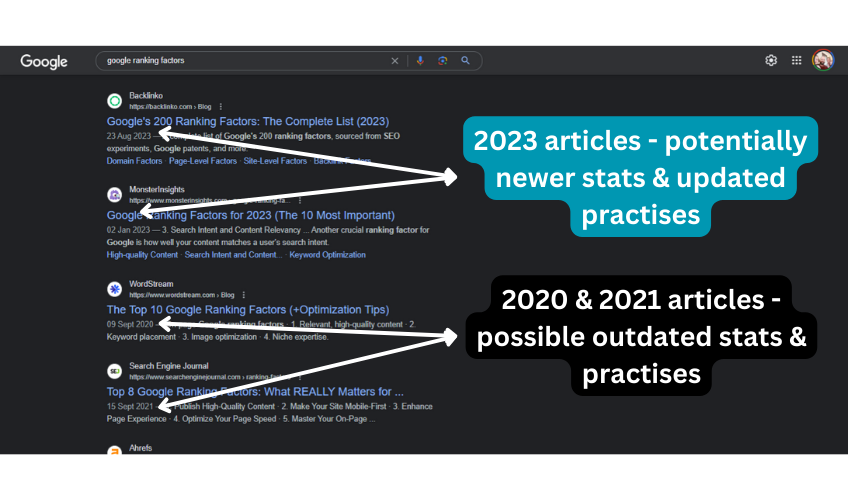
Compare that to the #1 result, which is a post on Backlinko. Instead of focusing on the year, Brian Dean keeps it continually updated, which means that it will continue to be the best result for searchers without losing its relevance.
3. iPod or Zune- which would you choose?
Almost 15 years ago now, the race for the portable mp3/mp4 player began.

Apple launched the iPod classic, soon followed by the iPod touch, while Microsoft launched the Zune.
The Zune was a pretty colossal failure, while the iPod went on to help Apple become even more of a leader in technology.
The funny thing is that many argued that the Zune’s functionality was better than that of the competing products. The problem was that it was bulky and ugly and not exactly the cool product to be seen with.
In short: looks matter.
And just like a case and logo affect the user experience with an mp3 player, the design of your website affects the user experience of any of your readers.
Even with the same content, two designs can yield drastically different results. Users may love one while not even reading through the other.
If you want to create better content for a search, start (or finish) by improving the appearance.
Formatting technique #1 – Include images (bonus for custom): We all have instincts. If someone throws something at you, you automatically flinch. For most online readers, if they see a page of nothing but text, they automatically run.
A wall of text looks exactly like a textbook. If you make reading your content seem like work, very few readers will try to read it.
We primarily break up text (besides keeping paragraphs short) with images. We process images up to 60,000 times faster than text. It’s much easier to look at a picture than it is to read a paragraph.
The research on great content says that 10 images is the optimal number per blog.
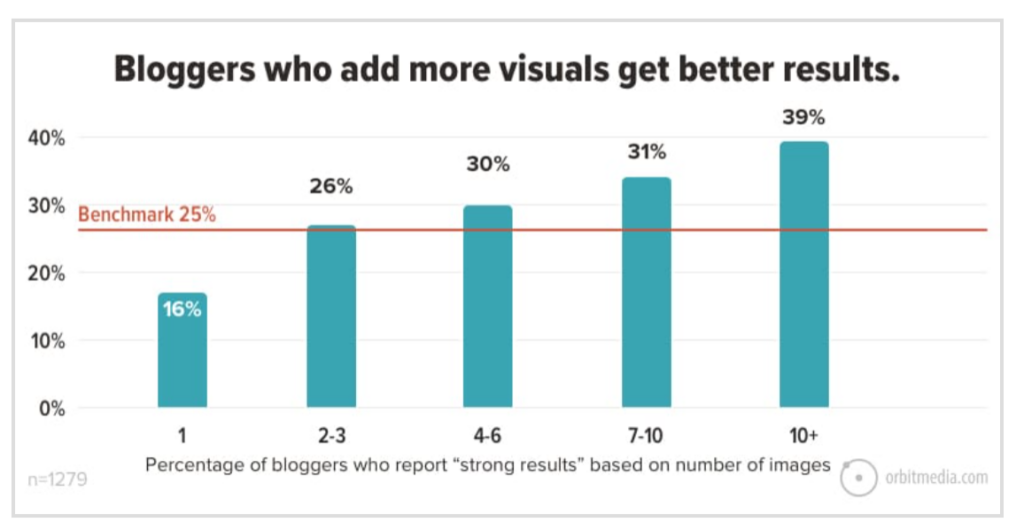
Any image is better than none, but some are better. In our experience, here are the best types of images to use in blog posts:
- graphs
- charts
- stock images
- custom images
- cartoons/comics
Graphs and charts are especially useful as they can help support your points and communicate important information. They’re also cheap since you can typically link to a source or create them yourself.
Custom images are fantastic but are more resource-intensive. They will get you more social shares and backlinks, but take more time to make. You can either pay a designer to create them or create your own.

Formatting technique #2 – Create a custom layout: If you want to take a piece of content to the next level, create a custom layout. This is not easy or cheap (in time or money), so you can’t always do it.
However, important content, like our definitive guides, is worth it.
So what do we mean by a custom layout?
With a typical blog post, formatting is always the same. This isn’t a bad thing, but it limits you.
In Backlinko’s comprehensive link-building guide, Brian Dean has a user-friendly, aesthetically pleasing table of contents:
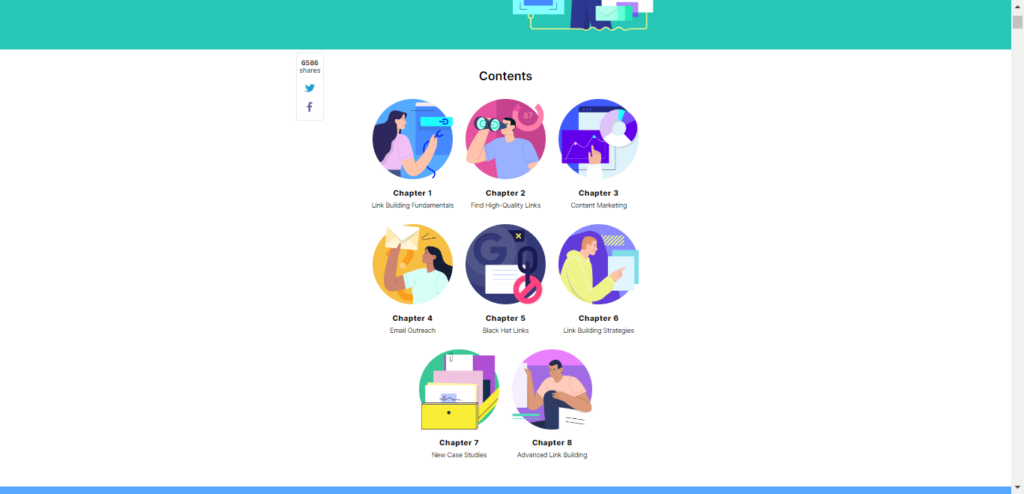
And different backgrounds/fonts:
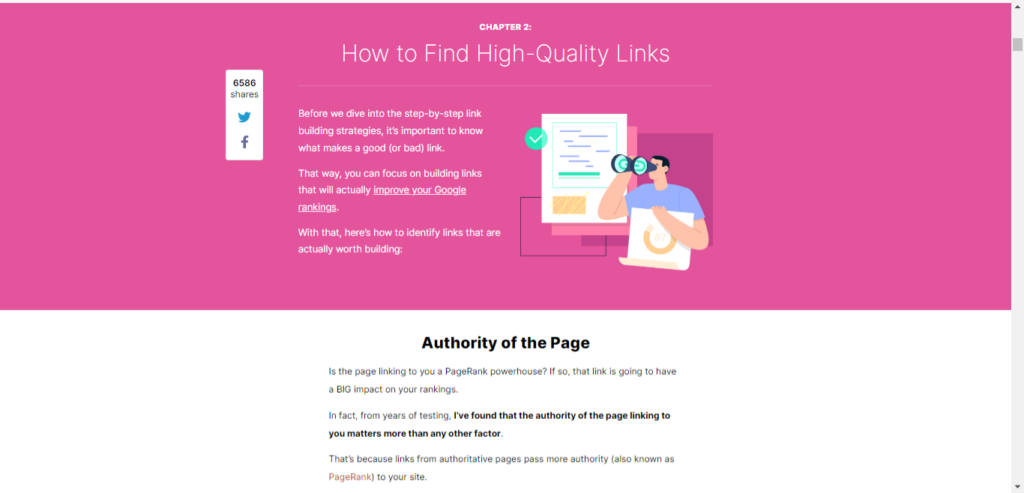
And an uncluttered layout to help readability.
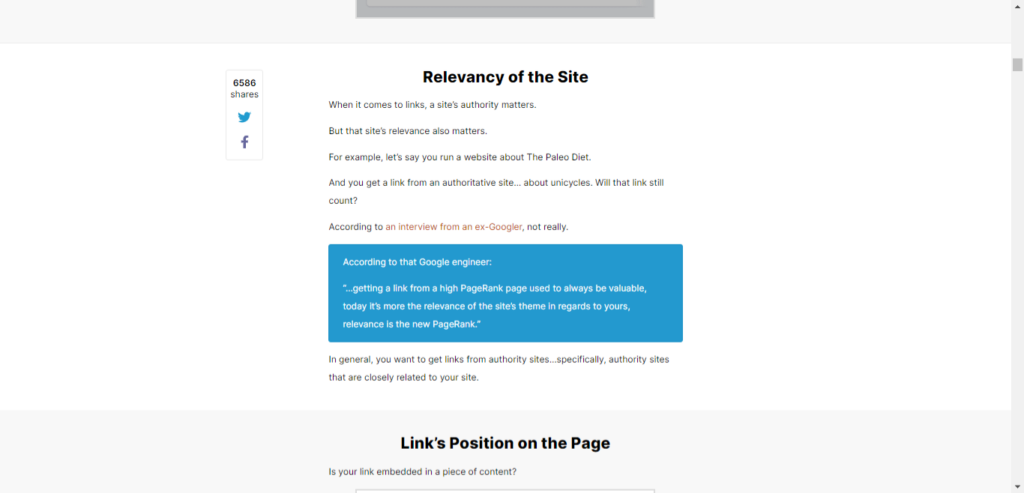
You can decide how much time and money you want to invest in a particular guide. But the more you do, the more readable and useful it typically becomes, which will help you rank #1.
Formatting technique #3 – Use lists whenever possible: People love to skim the web. They typically read no more than 43% of the content.
There are many reasons to use lists:
- They are more readable (easier to skim);
- They break up content; and
- They are much less awkward than long-winded sentences.
Formatting technique #4 – Structure for maximum readability: People like to read fast, partly because they skim. But they also do it because they have limited time, and so much content is vying for their attention.
You need to make your content as reader-friendly as possible. The easier it is to read, the more likely someone will read enough of it to be drawn in to pay closer attention to it.
The main key is to have a clear structural hierarchy. By that, we mean that your content needs to be logically organized within an article.
That’s where subheadings come in.
Headings are typically in an H2 tag format, and subheadings are H3. This way, they stand out. Readers can skim through an article and easily identify the subheadings. If one catches their interest, they’ll dig into it.
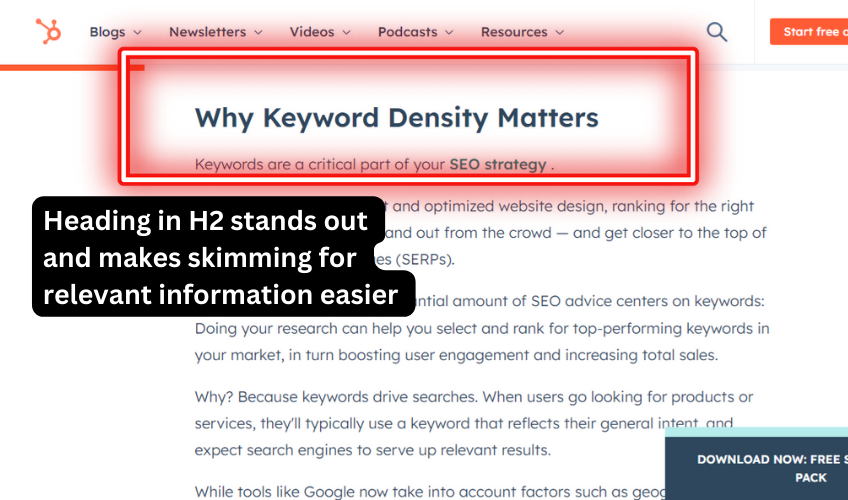
Here’s where our formatting on Quick Sprout is different. Most blog posts are sometimes written with H3. Each sub-subheading is on its own lines and stands out from the rest of the text.
The problem with this, from our perspective, is that it is really difficult to tell them apart when skimming. Each type of heading tag is typical of a similar color and size.
So how is a reader supposed to differentiate them from each other? They can’t—not easily, at least.
Instead of skimming the article and paying attention to a select few important headings, readers keep scrolling through. That’s because nothing is likely to catch their attention when there are too many subheadings.
But, of course, sometimes you need to break up a section further or increase the impact of specific information. HubSpot provides snippets of key information in a pop-out box, which is likely a customized quote block:
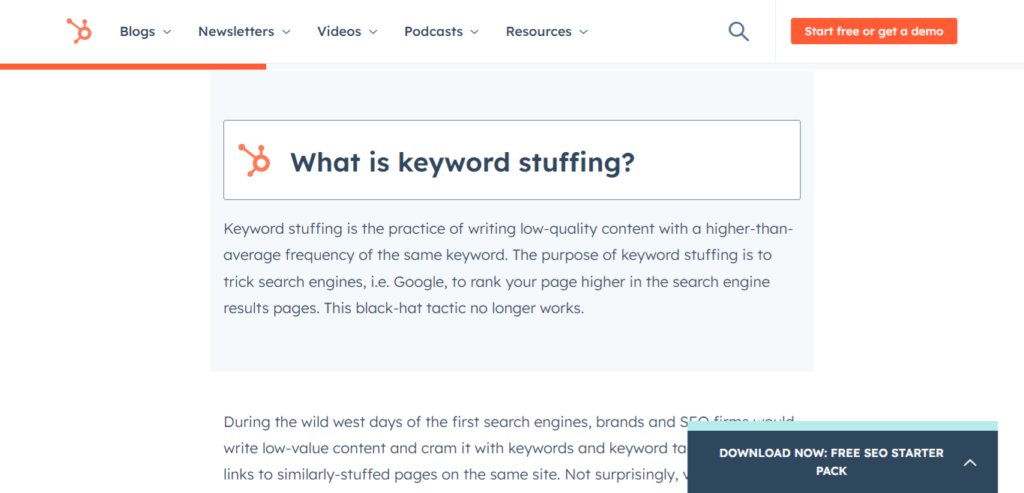
Since the bold doesn’t span the entire line and is not any bigger than the rest of the text, it won’t interfere with skimming. However, if someone is actually reading the section, it will be clear that the bold description is the beginning of a sub-section.
That’s a small tweak that can produce significant results in terms of user experience.
4. Give them something they can believe in
Blogs originally were created as sorts of online personal diaries.
Since then, they’ve evolved to be much more informative and entertaining. Because of that, anyone can create a blog overnight and post as an expert, even if they aren’t.
That leads to a lot of wrong advice, even if it’s not written like that on purpose.
So when someone makes a claim or statement in a blog post, most readers are left with a thought: “Is that really true?”
While this is one of the toughest puzzle pieces for Google, having credible content is important. The #1 result needs to be content that users can trust.
Our best guess is that Google uses user interaction metrics to determine the credibility of the content. If you use either of the two methods, we’ll show you, and readers will trust your content more and stop searching for alternatives, which should help your rankings.
Option #1 – Interview or cite experts: If we’re writing a blog post, we must convince you that we’re experts who should be trusted.
This is where we ran into problems with the nutrition blog. Since we’re not a licensed nutritionist, we cannot offer any opinions and expect them to be taken seriously.
However, interviewing nutritionists and including quotes throughout the article would add a huge amount of credibility to our points.
Think about what podcasts typically are. For example, Entrepreneur on Fire is among the most popular marketing podcasts. At first, John Lee Dumas was a nobody, so no one would listen to a show that was just about his entrepreneurial experience.
So what did he do? He invited a guest to join the podcast every episode. They were automatically credible because they had already succeeded and established themselves as experts. People wanted to hear their opinions, and that’s why the show got so popular.
After years of hard work, John is also considered an entrepreneurial expert, and people would tune into his shows, even if it’s just him talking.
But until you become an expert, use the credibility that other experts have already developed.
Option #2 – Support every claim with data: Expert opinions are one way to support a point. Another way that is equally as good in most situations (better or worse in some) is to cite credible data.
Many people have told us that we include ridiculous links in our posts, and they’re right. We try to back up every single claim if possible. The more data and references you can include, the more trusted your content will (and should) be.

There are many ways to find statistics, but the simplest way to start is to search for [your niche] + statistics.
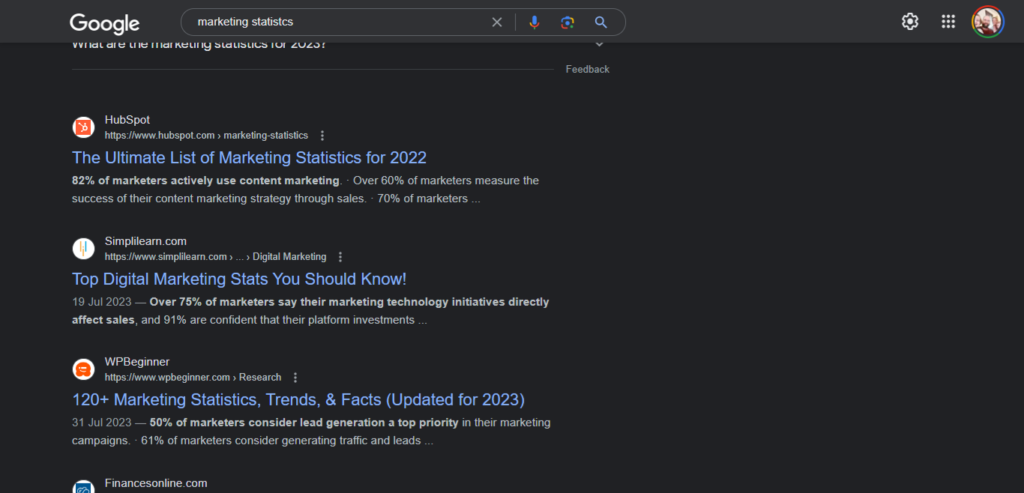
If you’re in a niche like marketing, there are many great resources with up to hundreds of useful statistics.
Often, you can also get even more specific. For example, we could look for content marketing statistics if we wrote an article on that subject.
5. Give readers control in complex situations
Your audience comprises many different types of people, even if they all have a common interest in your writing.
They have different times available to learn, different amounts of experience, different preferences for learning, and so on.
On top of creating great content, you can also give readers control over how they consume the content, leading to better user satisfaction—the key criterion for rankings.
Tactic #1 – Offer content in multiple formats: Some people are visual learners, while others like to learn by reading or listening. We’re big fans of giving people what they want.
That’s why we produce both long text-based articles and high-quality infographics on a regular basis.
We post them separately, but you can also combine an infographic with an article to give readers more options:
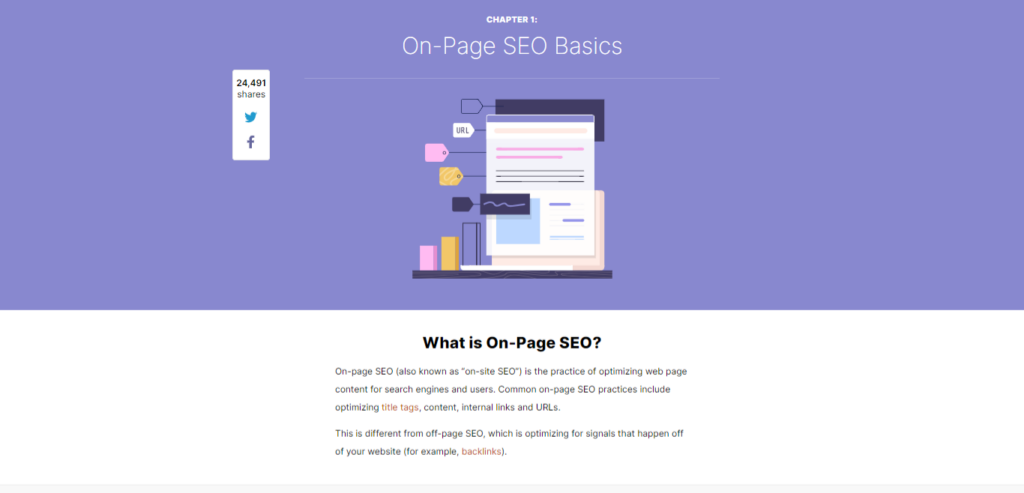
If you know that your readers might appreciate being able to save a copy of your article or print it out, you can offer a PDF version of the content.
Since these extra formats take extra resources to put together, it’s perfectly reasonable to ask for a social share or email address before giving them out (it’s up to you):
Not all articles lend themselves to multiple formats, but keep it in mind.
Tactic #2 – Include a table of contents: Remember we talked about how people skim? They scan the content for headlines. Why not just give it to them? That way, they can’t accidentally miss what they’re looking for because they’re scrolling too fast.
You can do this with a table of contents.
What’s that site that ranks decently for most terms? Oh yeah, Wikipedia, which actually ranks #1 for about 56% of searches. If you want to see great content, look at Wikipedia.
One thing Wikipedia does really well is it includes a table of contents on every single page.

It’s very simple, but it does exactly what it needs to. There are many WordPress plugins that you can use to create a similar table of contents in seconds.
Additionally, you can take it a step further on occasion. You can combine this tactic with improving the formatting of your content by making an image-based table of contents.

It will draw even more attention and make a great first impression on readers.
Tactic #3 – Let users filter out options: Some posts, especially list posts, can get out of hand once you compete with others.
For example, Backlinko has the biggest list of SEO tactics we’ve seen. We won’t count individually, but from a quick estimate, we think it has over 150 tactics on the page.
The average reader doesn’t want 150 options, even if it is impressive.
That prompted the author, Jon Cooper, to create a filtering mechanism.

You can check or uncheck the amount of time you have to implement a tactic, what it requires (dependencies), and the link value. Readers can take the massive list down to a few highly relevant and useful results, leaving them completely satisfied.
There aren’t any easy ways to implement this, so you’ll need to hire a web developer. But on a rare occasion when you end up with content that could be improved with a filter, it’s probably worth it.
Conclusion
Creating great content isn’t easy, but that’s the only way you will be able to achieve and sustain #1 rankings.
Think of each article as an investment. The more time and resources you spend making it the best resource on that particular topic, the more you will get out of it down the line.
But keep in mind that it will take time. It takes months of consistently publishing top-notch content to see any results, and you won’t get 100,000 visitors per month overnight.
The last major point I’d like to leave you with is don’t just use a single strategy or tactic from this article—combine them.
Think of a typical Quick Sprout article:
- Is it long and in-depth? – yes
- It is clear, simple, and actionable? – yes
- Is it user-friendly and readable? – yes
- Is it backed up with expert opinions and statistics? – yes
- Does it give readers multiple options? – Sometimes (this could be improved)
Our average article ticks four out of the five points for creating great content. That is how you create content that truly deserves to rank #1.
